
 Cover art: Water Wave courtesy of Brocken Inaglory: Coronal Mass Ejection courtesy of NASA/SDO and AIA, EVE, and HMI science teams. Copyright 2012 by John Wiley & Sons, Inc. Published by John Wiley & Sons, Inc., Hoboken, New Jersey. All rights reserved. Published simultaneously in Canada. No part of this publication may be reproduced, stored in a retrieval system or transmitted in any form or by any means, electronic, mechanical, photocopying, recording, scanning or otherwise, except as permitted under Section 107 or 108 of the 1976 United States Copyright Act, without either the prior written permission of the Publisher, or authorization through payment of the appropriate per-copy fee to the Copyright Clearance Center, Inc., 222 Rosewood Drive, Danvers, MA 01923, (978) 750-8400, fax (978) 750-4470, or on the web at www.copyright.com.
Cover art: Water Wave courtesy of Brocken Inaglory: Coronal Mass Ejection courtesy of NASA/SDO and AIA, EVE, and HMI science teams. Copyright 2012 by John Wiley & Sons, Inc. Published by John Wiley & Sons, Inc., Hoboken, New Jersey. All rights reserved. Published simultaneously in Canada. No part of this publication may be reproduced, stored in a retrieval system or transmitted in any form or by any means, electronic, mechanical, photocopying, recording, scanning or otherwise, except as permitted under Section 107 or 108 of the 1976 United States Copyright Act, without either the prior written permission of the Publisher, or authorization through payment of the appropriate per-copy fee to the Copyright Clearance Center, Inc., 222 Rosewood Drive, Danvers, MA 01923, (978) 750-8400, fax (978) 750-4470, or on the web at www.copyright.com.
Requests to the Publisher for permission should be addressed to the Permissions Department, John Wiley & Sons, Inc., Ill River Street, Hoboken, NJ 07030, (201) 748-6011, fax (201) 748-6008, or online at http://www.wiley.com/go/permission. Limit of Liability/Disclaimer of Warranty: While the publisher and author have used their best efforts in preparing this book, they make no representation or warranties with respect to the accuracy or completeness of the contents of this book and specifically disclaim any implied warranties of merchantability or fitness for a particular purpose. No warranty may be created or extended by sales representatives or written sales materials. The advice and strategies contained herein may not be suitable for your situation. You should consult with a professional where appropriate. Neither the publisher nor author shall be liable for any loss of profit or any other commercial damages, including but not limited to special, incidental, consequential, or other damages.
For general information on our other products and services please contact our Customer Care Department within the United States at (800) 762-2974, outside the United States at (317) 572-3993 or fax (317) 572-4002. Wiley also publishes its books in a variety of electronic formats. Some content that appears in print, however, may not be available in electronic formats. For more information about Wiley products, visit our web site at www.wiley.com. Library of Congress Cataloging-in-Publication Data: Hillen, Thomas, 1966 Partial differential equations : theory and completely solved problems / Thomas Hillen, I. p. cm. cm.
Includes bibliographical references and index. ISBN 978-1-118-06330-9 (hardback) 1. Differential equations, Partial. I. Leonard, I. Ed., 1938 II.
Van Roessel, Henry, 1956 III. Title. QA377.H55 2012 515.353dc23 2012017382
PREFACE
This textbook on linear partial differential equations (PDEs) consists of two parts. In Part I we present the theory, with an emphasis on completely solved examples and intuition. In Part II we present a collection of exercises containing over 150 explicitly solved problems for linear PDEs and boundary value problems. These problems are based on more than 30 years of collective experience in teaching introductory PDE courses at several North American universities.
Many excellent introductory textbooks on PDEs are available, and over the years we have used the monographs by Asmar [5], Brown and Churchill [11], Haberman [25], Keane [31], and Powers [41], to name a few. These books give a concise, detailed, and easily accessible introduction to linear PDEs, and provide a number of solved examples. However, students always ask for additional problems with detailed solutions, and they tend to benefit from a drill-like repetition of problems and solutions. Here we address exactly this need. While Part I presents the theory behind linear PDEs and introduces methods and techniques for solving them, the problems in Part II allow students to learn and repeat arguments in hands-on exercises. The problems in Part II are all completely solved and explained in great detail.
The final two chapters contain four sample midterm examinations and four sample final examinations. These sample examinations are actual exams given between 2004 and 2009 at the University of Alberta. They provide students with a useful guideline as to what to expect as well as an opportunity to test their abilities. To help students use the text, we have incorporated two special features. First, we rank the problems according to their difficulty; of course, this is a subjective task, but it gives a good indication of the level of difficulty anticipated. We use  The second feature of the text is a detailed summary at the end of each chapter, with cross-references to the solved problems in Part II.
The second feature of the text is a detailed summary at the end of each chapter, with cross-references to the solved problems in Part II.
Most colleges and universities now teach undergraduate courses in boundary value problems, Fourier series, Laplace transforms, or Fourier transforms, and then give applications to PDEs. The audience usually consists of third-year students of mathematics, engineering, and other sciences. The requirements are a solid grounding in calculus, linear algebra, and elementary differential equations. Students need to be familiar with the methods and techniques for solving linear ordinary differential equations (ODEs). Many ODE courses do not cover advanced topics such as Bessel's equation or Legendre's equation, and hence we include a full treatment in the chapters that deal with PDE problems in polar and spherical coordinates. In the past, physics and engineering have been a major source of interesting PDE problems; nowadays, problems come from other areas as well, such as mathematical biology.
These problems address such topics as the spread of epidemics, survival or extinction of populations, or the invasion of healthy tissue by cancer cells; see, for example, [2] or [19]. Although not all PDEs can be solved by separation of variables or transform methods, most of this text focuses on these two methods. This is not surprising, since they form the backbone of any study of PDEs. Furthermore, the method of characteristics is also covered. A choice of topics had to be made, and we chose to focus on the above three methods: separation of variables, Fourier transforms, and the method of characteristics, and to illustrate them in great detail. T. H. would like to thank Lisa for her help in organizing and indexing the solved problems from Part II. I. E. L. would like to thank Amanda for reading the entire manuscript numerous times. T. H. and I. E. L. would especially like to thank Michael Keane for visiting Edmonton to discuss an earlier version of the book. would especially like to thank Michael Keane for visiting Edmonton to discuss an earlier version of the book.
We will maintain a website at http://www.math.ualberta.ca/~thillen/pde-book-page.html with supplemental material and a list of errors and typos that readers find in the text. We hope that this book will provide useful assistance to all those interested in learning to solve linear PDEs and provide a glimpse of the beautiful theory behind them. THOMAS, ED, AND HENRY Edmonton, Alberta, CanadaMarch 2012
PART I
THEORY
CHAPTER 1
INTRODUCTION
Many physical, biological, and engineering problems can be expressed mathematically by means of partial differential equations (PDEs) together with initial and/or boundary conditions. Partial differential equations are used in basically all scientific areas: for example, Schrdingers equation in quantum mechanics, Maxwells equations in electrodynamics, reaction-diffusion equations in chemistry and mathematical biology, models for spatial spread of populations and heat conduction problems, and the Black-Scholes formula for financial markets. Defining PDEs mathematically is quite simple, since a PDE is an equation that involves partial derivatives. The fascinating aspect of PDEs is that most of them can be classified into three classes:
Next page
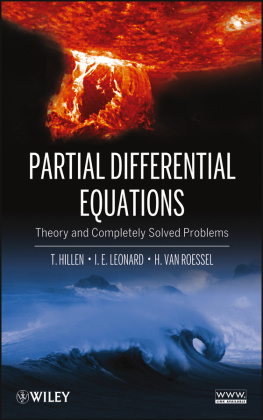
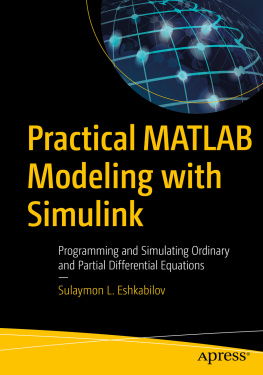
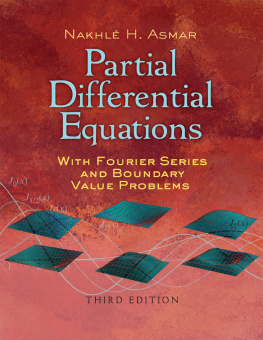

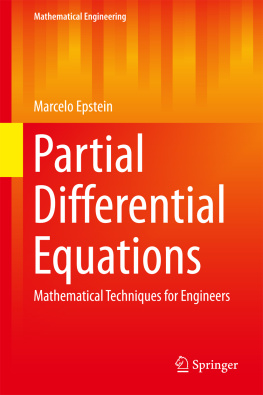
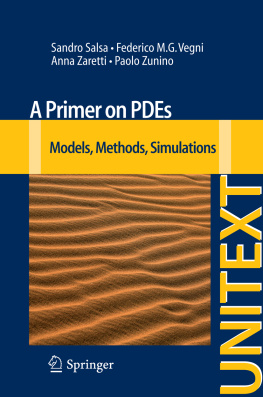


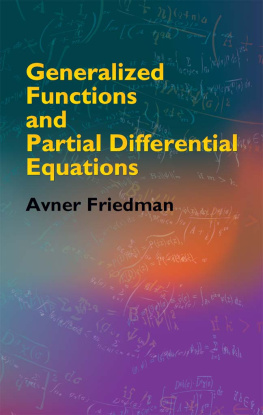


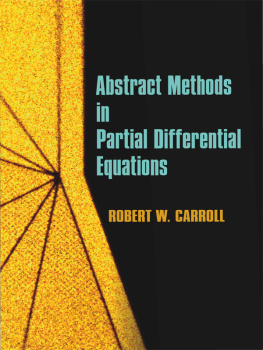
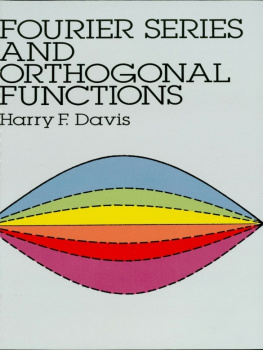

 Cover art: Water Wave courtesy of Brocken Inaglory: Coronal Mass Ejection courtesy of NASA/SDO and AIA, EVE, and HMI science teams. Copyright 2012 by John Wiley & Sons, Inc. Published by John Wiley & Sons, Inc., Hoboken, New Jersey. All rights reserved. Published simultaneously in Canada. No part of this publication may be reproduced, stored in a retrieval system or transmitted in any form or by any means, electronic, mechanical, photocopying, recording, scanning or otherwise, except as permitted under Section 107 or 108 of the 1976 United States Copyright Act, without either the prior written permission of the Publisher, or authorization through payment of the appropriate per-copy fee to the Copyright Clearance Center, Inc., 222 Rosewood Drive, Danvers, MA 01923, (978) 750-8400, fax (978) 750-4470, or on the web at www.copyright.com.
Cover art: Water Wave courtesy of Brocken Inaglory: Coronal Mass Ejection courtesy of NASA/SDO and AIA, EVE, and HMI science teams. Copyright 2012 by John Wiley & Sons, Inc. Published by John Wiley & Sons, Inc., Hoboken, New Jersey. All rights reserved. Published simultaneously in Canada. No part of this publication may be reproduced, stored in a retrieval system or transmitted in any form or by any means, electronic, mechanical, photocopying, recording, scanning or otherwise, except as permitted under Section 107 or 108 of the 1976 United States Copyright Act, without either the prior written permission of the Publisher, or authorization through payment of the appropriate per-copy fee to the Copyright Clearance Center, Inc., 222 Rosewood Drive, Danvers, MA 01923, (978) 750-8400, fax (978) 750-4470, or on the web at www.copyright.com. The second feature of the text is a detailed summary at the end of each chapter, with cross-references to the solved problems in Part II.
The second feature of the text is a detailed summary at the end of each chapter, with cross-references to the solved problems in Part II.